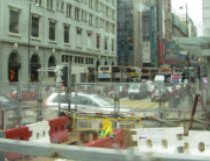It's 9 o'clock in the morning, and you're on your way to work. Except, you can't get there, because a big traffic maze is holding you up; some public utility has begun digging the road, for the umpteenth time, and there is no obvious way to pass this zone smoothly. After what seems like an eternity, some kindly soul gets down from his vehicle, and directs the traffic himself, briefly joining the traffic police without pay! If you happen to live and work in any major Indian city - and most smaller ones too, possibly - it's likely that you've experienced this frustration more than once. Generally, it takes a while before the traffic police are alerted, and several hours before any sign of normalcy returns. Moreover, it is very likely, you will encounter the same chaos for the next couple days too, before a traffic cop is assigned to manage the location until the work of the public utility is completed. Welcome to the work zone.
Locations on public roadways where any kind of construction or maintenance is ongoing are referred to as Work Zones. They are a significant source of traffic congestion, as small manouevres by traffic from many sides often results in a gridlock at the work site. Traffic accidents are likely to occur at these locations as well, since most work zones require a change of speed by moving vehicles, and can sometimes also involve difficult bumps on the road itself. A recent study conducted by the US Federal Highway Administration concluded that work zones cause 10 per cent of the traffic congestion. This number will be higher in India, which has a large number of ongoing construction and infrastructure projects, many of which spill on to the roads in an unregulated way.

|

|
| Work zone on the Western Express highway near the Gold Spot junction in Andheri, Mumbai (left). The signal is red; in about 30 seconds, a few hundred cars will come to this location at speeds between 30-45 kmph. Barriered work zone on an equally busy arterial in Hong Kong (right) makes traffic much more manageable and safe. | |
Work zone management
Work zone management involves understanding the type, severity and extent of the impact on the roads from work that is ongoing, and developing appropriate mitigation strategies or measures to manage the movement of vehicles for the duration of the work. The authority and responsibility for this must specifically rest with some department, but often this role is not assigned to anyone. Traffic police departments are in the best position to develop the administrative capacity to enable informed and organised work zone management, and given that they are called upon to deal with congestion, it will greatly help them to pursue this. The investment required is relatively low, and the return on this investment - in terms of travel-time savings - is high. Part or all of the cost can be recovered from the agency whose work creates the temporary disruption on the roads.
A few simple steps can address much of the need for management. It should be the responsibility of the agency to apprise the traffic department of the work plans. The agency should furnish information about the project including location, start date, duration, area involved, etc. In return the traffic police can provide three basic services
-
A plan to regulate and channelise traffic around the work zone. This should include, traffic engineering, and developing alternate routes.
-
The on-site and other personnel required to execute the plan.
-
Illumination and barriers around the work zones. These work zones are death traps, especially at night where it can be difficult to spot unfamiliar changes in road conditions.
A specialised group within the traffic police can develop the above capabilties; their expertise can then help them double up in another important role - assuming responsibility for clearing and managing traffic around accidents and other incidents.
Work zone management should feature on all traffic congestion improvement priority lists. Long-term infrastructure development is an area where work zone management is especially needed, since the impact from ongoing work will often last many months. With appropriate planning for managing work zones, the public's patience with long-term projects will also be higher. Recently Bangalore launched B-Trac 2010, a 10-point programme to address the city's traffic problems. B-Trac 2010 includes a substantial number of infrastructure projects, some of which will be completed over many years. The Metro that is planned for the city is one such project, and at several locations along its track, work zone disruptions on road space will become inevitable. Other cities too - Chennai, Kolkata, Hyderabad - are considering their own solutions for mass transit. Adding work zone management to the construction operations is important; the cost to introduce a programme for work zone management will be miniscule compared to the overall costs of the project itself.
Advocacy and citizen engagement
Advocacy is extremely important to realise the full potential of initiatives to manage work zones proactively. Information about work zones, start date, duration, etc. can easily be provided on websites and newspapers, and prominently displayed at the work sites themselves. Maps of diversion routes to be used during the period of disruption should also be provided through these channels. Offices located near work zones can then display these noticeably in their premises too, advising likely users of the area of planned changes.
Citizens' groups can play an important part too. We should seek and obtain information about upcoming dig-ups and the precautionary measures takes by management agencies to prevent traffic congestion. We must ask for effective barriers and adequate illumination to be provided around work zones to ensure public safety. And when these are provided, it is important that we obey the signs and detours created around the work zone. When that happens, we'll no longer need to get down from our vehicles and play traffic cop ourselves!!
























